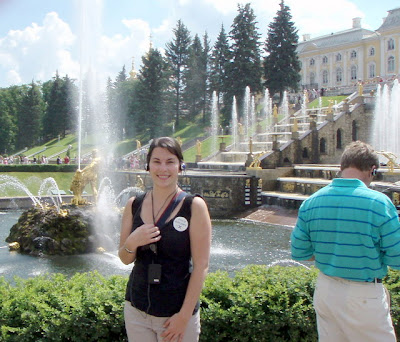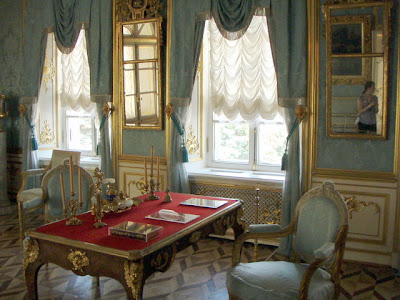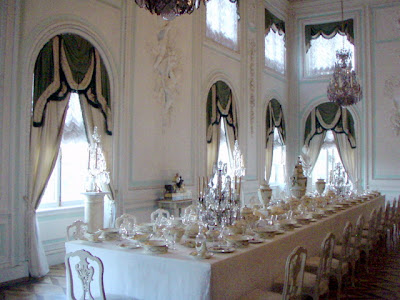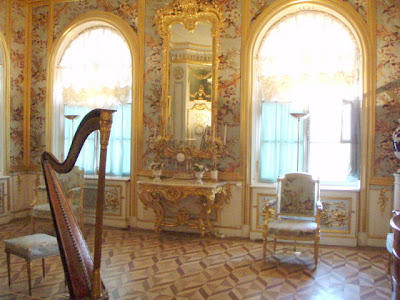Catherine's Palace and Peterhof
 The best thing about my otherwise crappy job is that all of my port days are free time for me. Generally, the casino can’t open in port, so all the dealers head outdoors to explore, eat, shop, lie on the beach and otherwise entertain themselves away from the ship.
The best thing about my otherwise crappy job is that all of my port days are free time for me. Generally, the casino can’t open in port, so all the dealers head outdoors to explore, eat, shop, lie on the beach and otherwise entertain themselves away from the ship.It is a wonderful thing, and what makes it even better is that in Europe you can spend your port time volunteering as a “tour escort”. Basically this means you go on (often expensive) tours, do lots of head counts and a little socializing with the guests and in return, get to take all the tours for free.
The tours go to the places everyone wants to see – landmarks, museums, glaciers, mountains, palaces and a whole lot more.
Since I’ve been here I’ve done 10 tours at a value of about $830, all for free. I’ve eaten free lunches, had free admission to attractions, free transportation and gotten to visit places so out of the way or exclusive, I probably wouldn’t have made it to most of them on my own. Two of these places were Pushkin and Peterhof, both outside St. Petersburg.
This, I must say, is the best tour I’ve done so far. Catherine’s Palace in Pushkin and Peterhof, Peter the Great’s magnificent summer palace, are among the most amazing buildings I’ve ever seen.
Pushkin, 25 kilometers outside St. Petersburg, is a palace built by the Empress Catherine, the second wife of Peter the Great between 1717 and 1723. It was later updated with its amazing Baroque façade in turquoise, white and gold. Its façade is over 1000 feet long, and the palace is truly enormous. The palace itself was almost entirely destroyed by Nazis during World War II and now has been painstakingly restored to its present state.
 My first eyeful of Catherine's Palace.
My first eyeful of Catherine's Palace.
Its size is really quite overwhelming.



 The staircase as we entered.
The staircase as we entered. This is the throne room in Catherine's Palace. It is amazing to see. There is so much gold, interspersed with candles, windows, and mirrors, which make the room appear even bigger than it is. Stunning.
This is the throne room in Catherine's Palace. It is amazing to see. There is so much gold, interspersed with candles, windows, and mirrors, which make the room appear even bigger than it is. Stunning.


 Cupid sleeping.
Cupid sleeping. Just a couple of the many opulent rooms.
Just a couple of the many opulent rooms.


And the beautiful grounds.
 These folk singers and dancers were the entertainment at lunch.
These folk singers and dancers were the entertainment at lunch.
As I stood outside Peterhof, drinking in its beautiful grounds and fountains, the yellow façade glowing in the sun, the gold of the statues glinting and twinkling, I was in awe. I have never, ever, seen such a beautiful building and property in my life. It was the kind of view I just wanted to stand in front of all day, to walk around and see from all its angles. It is truly a work of art.
The park surrounding the palace at Peterhof is made up of 176 fountains and four cascades, the largest of which, the Grand Cascade, flows down the steps in front of the palace.
The really remarkable thing about these fountains and cascades (besides their beauty), is that they all operate without pumps. The water comes from natural springs – St. Petersburg was built on a swamp – and is collected in reservoirs in the Upper Gardens. The pressure from the elevation difference propels the water through all of the fountains in the Lower Gardens, in front of the palace, including the Grand Cascade. The grounds are also home to a number of joke fountains, positioned so that they soak bystanders, or people sitting on benches, for example. Apparently, Peter the Great was something of a prankster.









 The east chapel on the palace grounds.
The east chapel on the palace grounds.


Inside, the palace is decorated with gold, elegant plaster and silk and brocade, imported from Asia.


 The throne room.
The throne room. A portrait of Catherine the Great, who often dressed in uniform and rode on horseback, leading the army.
A portrait of Catherine the Great, who often dressed in uniform and rode on horseback, leading the army.








 The spectacular view from the palace over the Lower Gardens.
The spectacular view from the palace over the Lower Gardens.As amazing as it was to visit these two palaces, I couldn't help but remember what one guest had said to me after visiting Russia - that when you visit these palaces and see the incredible wealth that the tsars and the Romanov family possessed, it is not hard to understand why there was a revolution in this country. Indeed, it is true. This is a country where huge numbers of people were starving to death and were led by a royal family that had little concern for their citizens, choosing to live in incomparable luxury and ignore the state of the populace. It is a little hard to imagine now, but it is, definitely, one of history's disturbing facts.

































